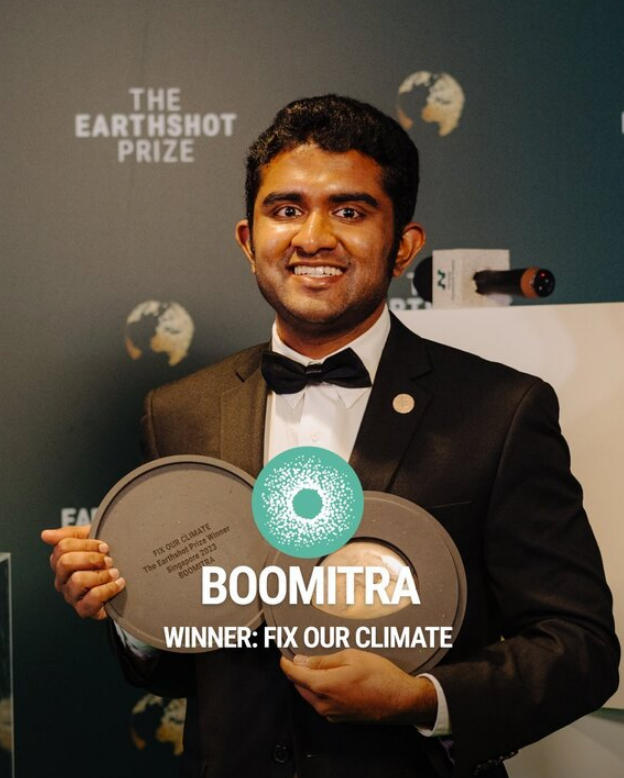Boomitra, a company led by Stanford Ph.D. dropout Aadith Moorthy, won the 2023 Prince William’s Earthshot Prize, the organization announced in November.
Moorthy was pursuing a Ph.D. in battery chemistry when he left Stanford in 2020 to pursue Boomitra, a company that helps to reduce carbon emissions through carbon credits for farmers around the world. Moorthy, who has a bachelor’s degree in computer science from The California Institute of Technology, was also recently named on the Forbes 30 Under 30 list for social impact.
The Earthshot Prize, which was inspired by John F. Kennedy’s “Moonshot” challenge, awards “innovative solutions to the world’s greatest environmental challenges,” according to its website.
Shelley Northrop, Boomitra’s vice president of marketing, described the prize as having the same prestige as “winning an Oscar in the realm of climate action.”
“I am exhilarated!” Moorthy wrote. “This award stands as a testament to the passion the Boomitra team has poured into every aspect of our work and validates the strength of our technology, solution and the partners and growers we work with, who work every single day toward moving the needle on climate change.”
The prize is awarded to five nominees in different categories. Boomitra was awarded under the “Fix Our Climate” category.
Boomitra focuses on two interlinked aspects of climate improvement: soil and carbon emissions.
“We know that restoring soil carbon has the potential to remove 10% of humanity’s annual emissions,” Moorthy said. Since 2018, Boomitra has removed 10 million tons of CO2 from the atmosphere.
In addition to global recognition, Boomitra received £1 million for the Earthshot Prize. Moorthy said the organization plans to accelerate growth and scale to new markets, with the next step scaling up from a megaton scale company to gigaton.
“Our goal is to make our technology and model available to every farmer and rancher around the world so they can improve their soil and increase their income by participating in the carbon credit market,” he said.
Consequently, Boomitra aims to both revitalize farmland and reduce atmospheric carbon dioxide by sequestering carbon dioxide in soil.
To do this, they first need to get soil data in the regions they work with. Instead of asking farmers to take samples of their soil to determine their composition, Boomitra accomplishes this through a variety of public and private satellites. They use machine learning models trained with known data about the soil to cross-compare and detect changes in soil properties, making sure the carbon in the soil is improving.
Boomitra offers its incentives to farmers in the form of carbon credits.
“The incentive to farmers is really two-fold: first, the farmers and ranchers will gain income from the sale of the carbon credit; second, the farmers and ranchers are regenerating their soil and increasing their resiliency to future weather disruptions,” Moorthy said.
Carbon credits are essentially allowances for farmers’ carbon emissions; if farmers do not use up their allowed emissions, they can sell the credits for profit. Through this, Boomitra manages to also provide a safety net for the finances of the farmers.
“Farming is a hard business and shifting the way you manage your land, crops and herds can be risky or frightening,” said Moorthy. “When a farmer or rancher signs up to work with Boomitra and our partners, we shoulder some of that risk for them, we give them the support and knowledge they need to undertake such big changes.”
Moorthy’s motivation for Boomitra came from his experience while traveling through India. He was passing through a remote village in South India when he witnessed the funeral procession of a farmer, who had committed suicide.
“This farmer had taken his own life after he was left destitute from the failure of monsoon rains that caused his crop yields to collapse —an effect of climate change,” Moorthy said. “With a background in materials science, computer science and artificial intelligence, I wondered: How can technology help?”
Material science and engineering professor William Chueh, who worked with Moorthy during his Ph.D. program, said Moorthy is “very unique as a person” because “he always worked backward from the solution that he needs to deliver at the end.”
“He always said, ‘What’s the big problem?’ and ‘How does he do fundamental research and development to address the final problem?’”
Moorthy worked on inexpensive energy storage in his Ph.D. program at Stanford, working toward the goal of making wind and solar energy more accessible. Chueh said Moorthy has kept the same mindset of working backward from the big problem both at Stanford and with Boomitra.
“I was not surprised when he started work on his company because he also worked backward. He basically said, ‘Well, what is a pressing problem?’ — and for decarbonization, it’s to really properly account for the CO2 removed in agriculture,” Chueh said.
Moorthy said his time at Caltech and Stanford was critical in teaching him about the power of technology to solve big problems.
“Both schools gave me the skills, innovative mindset and support system necessary to ideate and develop Boomitra’s defining technologies,” he said.
